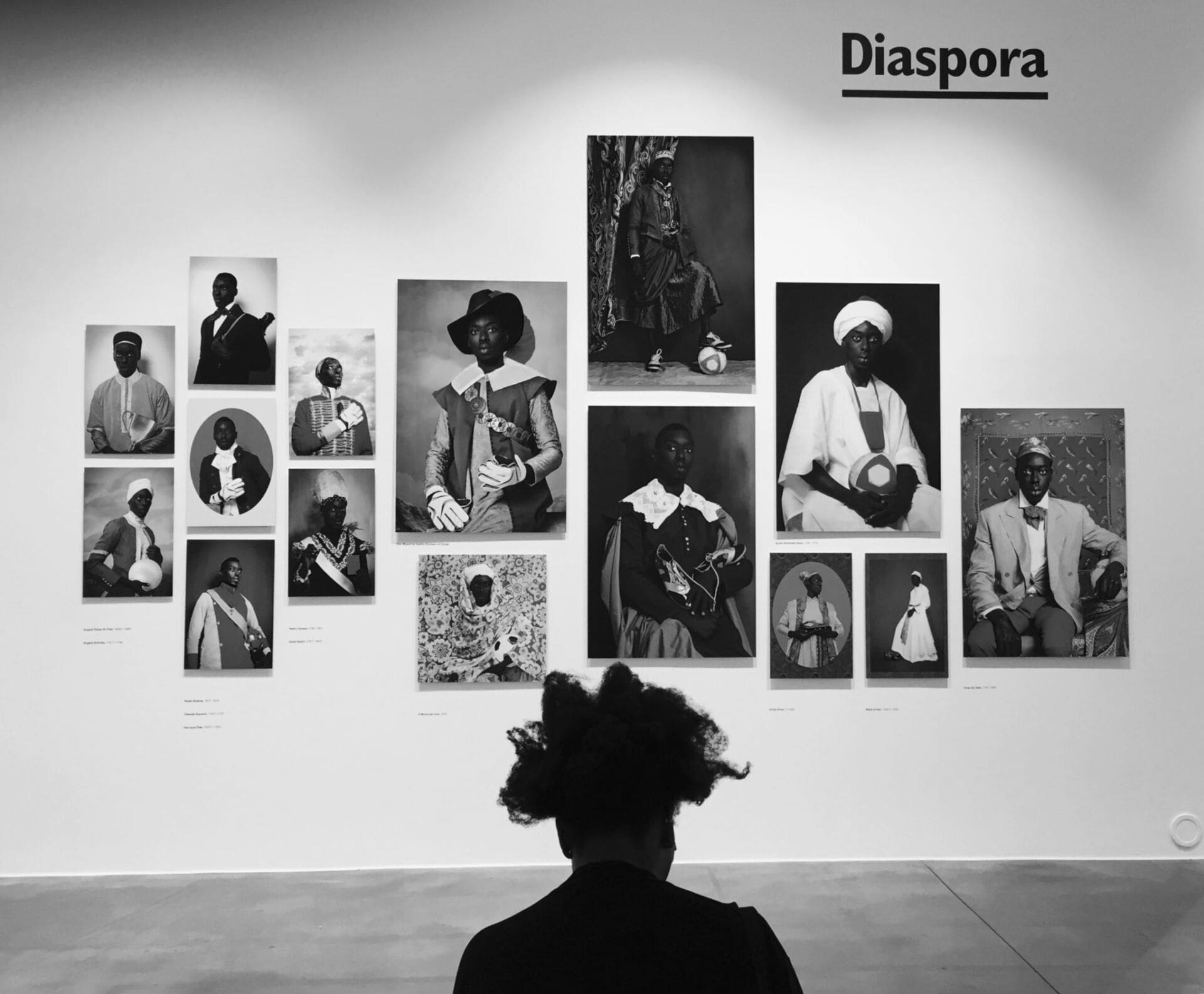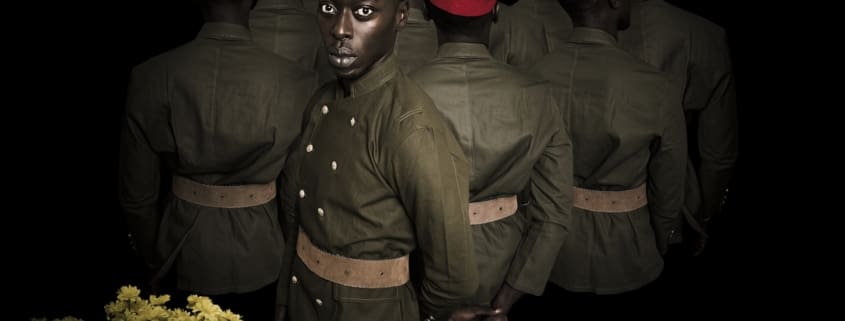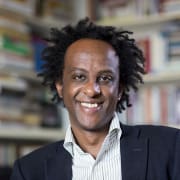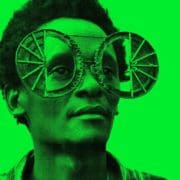Los paralelismos de Omar Victor Diop
En la sala 635 del Museo Metropolitano de Nueva York reside el retrato de Juan de Pareja, asistente de Diego Velázquez, que el propio pintor sevillano realizó en 1650. Recoge la información del museo que, según uno de los biógrafos del artista, cuando este hito del retrato occidental se exhibió por primera vez «recibió tal aclamación universal que, en opinión de todos los pintores de diferentes naciones, todo lo demás parecía pintura, pero esto solo como verdad.»

Exhibición Diaspora Omar Victor Diop / Foto: javidmgz
El aplauso quizás venga, como se recoge en la Wikipedia, por la destreza de Velázquez “de dotar de dignidad a los personajes que, por su profesión o condición, carecen de ella en la consideración social”. Es el primer cuadro que se conoce de un de hombre español con descendencia negra: Juan de Pareja, un hombre mestizo, hijo de una madre africana y un español; y esclavo, aunque Velázquez le otorgó la libertad años más tarde e iniciaría su carrera como pintor independiente en Madrid.
- Retrato de Juan de Pareja realizado por Diego Velázquez en 1650
- Juan de Pareja 1606? – 1670 © Omar Victor Diop
En la galería Autograph, al este de Londres, se homenajea a Juan de Pareja en una fotografía en la que no se ve al antequerano, sino al fotógrafo senegalés Victor Omar Diop. Es el propio fotógrafo el que sustituye al pintor, al igual que lo hace en toda la serie ‘Diáspora’, con la que Diop recrea pinturas históricas entre el siglo XV y el XIX de africanos que consiguieron notoriedad. Pero el senegalés dota de simbología futbolera a sus imágenes para abordar paralelismos sociales.
Juan de Pareja, Frederick Douglas, Olaudah Equiano, Albert Badin o Jean-Baptise Belley son la excusa para lanzar preguntas sobre la figura de los futbolistas africanos en Europa. Diop viaja al pasado y se pregunta si la reputación ganada por los personajes históricos es comparable a la de los futbolistas. Todos tuvieron que enfrentarse a los abusos raciales y a la discriminación, pero finalmente se ganaron un lugar en la sociedad. ¿Un espejismo?
“El fútbol es un fenómeno global interesante que para mí revela a menudo dónde está la sociedad en términos de raza. Cuando se observa la forma en que se percibe la grandiosidad del fútbol africano en Europa, existe una curiosa mezcla de gloria, adoración heroíca y exclusión. De vez en cuando, hay cantos racistas o se lanzan pieles de plátano al campo y toda la ilusión de integración se destruye de la manera más brutal. Es esta paradoja la que estoy investigando en el trabajo”, dijo el artista sobre el proyecto en una entrevista a The Guardian

Alin Sitoe Diatta (Senegal, 1944) and Trayvon Martin (Florida, 2012) © Omar Victor Diop
La galería Autograph acoge esta primera exhibición en solitario en el Reino Unido del fotógrafo senegalés. Pero la muestra, comisionada por René Mussai y Mark Sealy, regala además otra serie de
fotografías que apelan a la resistencia política negra.
En 1944, desterrada en Tombuctú, murió con tan sólo 24 años Aline Sitoé Diatta. Conocida como la ‘Juana de Arco’ senegalesa, Diatta luchó contra la colonización francesa. La joven se levantó contra el imperio. Y eso le costó la vida.
Otra muerte. Otro joven. Diop juega de nuevo con el paralelismo histórico para llegar hasta los movimientos sociales más actuales. En 2012, una manifestación rendía homenaje en la neoyorquina Union Square a Trayvon Martin. Disparado por un hombre blanco, que evadió la cárcel justificando una actuación en defensa propia, el fallecimiento de Martin fue el detonante para el movimiento Black Lives Matter.
Con ‘Liberty: A Universal Chronology of Black Protest’, Diop se autorretrata para honrar aquellos que se levantaron contra el colonialismo u otra forma de opresión. Es un relato cronológico de los movimientos sociales o protestas negras que van desde las marchas en Selma, en 1965, a los disturbios liderados por las mujeres nigerianas en 1929 contra los administradores británicos. El fotógrafo senegalés también se detiene en la masacre de Thiaroye, donde soldados africanos que lucharon junto al ejército francés en la II Guerra Mundial fueron asesinados por el propio bando galo en 1944, cuando exigían los pagos que se le debían.
“La historia de la protesta negra es rica, ya sean revueltas de esclavos, marchas por la libertad o contra el apartheid, movimientos por la independencia o contra la violencia policial. Hay retratos de metáforas en los que la idea de identidad negra es central. Disfruté siendo el sujeto y el objeto de estas fotografías, sin embargo, no son autorretratos en el sentido tradicional”, apunta el fotógrafo.
Las causas de ayer son las mismas que las de hoy. Y Diop muestra «una narrativa reinventada de la historia de los negros y, por lo tanto, de la historia de la humanidad y del concepto de libertad».
- Omar Victor Diop, Frederick Douglass 1818–1895. From Project Diaspora (2014) © Omar Victor Diop / MAGNIN-A, Paris Frederick Douglass was an African-American social reformer, statesman and abolitionist celebrated for his accomplished oratory and writing skills. After escaping from slavery in Maryland in 1938, he became a national leader of abolitionist movements in New Yorkand Massachusetts. He wrote three acclaimed autobiographies detailing his experience as a slave:Narrative of the Life of Frederick Douglass, an American Slave (1845), My Bondage and My Freedom (1855) and Life and Times of Frederick Douglass (1881). In 1847 he founded his own abolitionist newspaper, North Star. Douglass made several trips to Europe, and during one of his visits to England he became legally free when British supporters raised funds to buy his freedom from his American owner. He was the most photographed American of the nineteenth century, and he is also remembered for being the first African-American to be nominated for the position of Vice President of the United States. A symbol for freedom, human rights, equality, Douglass also supported campaigns for women’s suffrage. Original portrait by Samuel J. Miller.
- Omar Victor Diop, Selma 1965. From Liberty (2016). Courtesy © Omar Victor Diop / MAGNIN-A, Paris Between 7 and 21 March 1965, three protest marches to demand the right to vote for African-American citizens were held along the 80-kilometre highway linking Selma to the state capital of Montgomery inAlabama, USA. These pivotal marches represented a defining moment in the struggle for civil rights and were instrumental in the fight for black voting rights. During the first of these marches, on 7 March, 600 protesters demanded an end to discrimination in voter registration, many of whom were severely attacked by law enforcement agencies, state troopers and white separatists. This event became known as Bloody Sunday. Dr Martin Luther King participated in the subsequent marches, on 9 and 17 March. Numerous killings, abuse by the police and the Ku Klux Klan, aswell as the legal battles that marked the weeks of protests, all drew the attention of the national and international community to the issues of civil rights. The marches led to the signing of the Voting Rights Act of 1965.
- Omar Victor Diop, Breakfast for the Children of the Black Panthers 1969. From Liberty (2016). Courtesy © Omar Victor Diop / MAGNIN-A, Paris The Free Breakfasts for Children initiative was a revolutionary community programme started by the Black Panthersat their headquarters in Oakland, California. It was one of the first school food programmes in the country, providing free breakfasts to disadvantaged children each morning. Based on the belief that children could not take full advantage of their education by going to school hungry, it reflected the Black Panthers’ key message of self-determination and illustrated their belief in the importance of education. The programme was funded through donations from within the communities being served, receiving support from local stores, churches and groceries. In its firstyear, the programme became so popular that it was extended all over the United States, and by the end of 1969 the Black Panthers were serving full free breakfasts to 20,000 school-aged children in 19 different cities. Inspired in part by the ideas and actions of the Black Panthers in the 1960s, the US Department of Agriculture later started their own School BreakfastProgramme, which feeds nearly 13 million students daily.
- Omar Victor Diop, The Women’s War 1929 . From Liberty (2016). Courtesy © Omar Victor Diop / MAGNIN-A, Paris In 1929, tens of thousands of south-eastern Nigerianwomen rebelled against British colonial powers in whatis known as the Women’s War, or the Aba Women’s Riots. This insurgent movement brought together morethan 25,000 women in a fight against policies imposed by British authorities: in particular, special taxes levied on female market traders, which were implemented by male leaders (warrant chiefs) appointed by a colonial governor. The women rebelled above all to preserve the status they had held in their traditional societies before the arrival of the British, who felt the matriarchal system was against the moral order. The women’s activism prompted colonial authorities to drop their plans and to reduce the power of the warrant chiefs.Considered as the first major challenge to British authority in Nigeria and West Africa during the colonial period, the Women’s War took months for the government to suppress, and became a historic example of feminist and anti-colonial protest.
- Omar Victor Diop, Pedro Camejo 1790 – 1821. From Project Diaspora (2014). Courtesy © Omar Victor Diop / MAGNIN-A, Paris Pedro Camejo was born in San Juan de Payara, Venezuela. Better known as ‘Negro Primero’ or ‘The First Black’, he fought in the rebel army during the Venezuelan War of Independence, reaching the rank oflieutenant. He was one of the 150 lancers who participated in the Battle of Las Queseras del Medio (1819), for which he received the Order of Liberators ofVenezuela. He died in the Battle of Carabobo on 24 June 1821, an event that led to the independence ofVenezuela and the establishment of the Republic of Gran Colombia. Camejo was given the nickname ‘Negro Primero’ for his great weaponry skills, courage and bravery, fighting at the forefront of the battlefield.
- Omar Victor Diop, Omar Ibn Saïd 1770 – 1964. From Project Diaspora (2014). Courtesy © Omar Victor Diop / MAGNIN-A, Paris d, nicknamed Uncle Moreau and Prince Omeroh, was an Islamic scholar born to a wealthy family in Futa Toro, a northern province in modern-day Senegal, where he extensively studied arithmetic andtheology with prominent Muslim scholars. He was taken captive during a military conflict, and brought to the United States in 1807. Although he remained enslaved for the rest of his life, he authored a series of works on history and theology, including 14 manuscripts written in Arabic, and a memoir entitd, Slave in North Carolina, 1831. He died in North Carolina in 1864. Original portrait by an unknown artist.
- Omar Victor Diop, Ayuba Suleiman Diallo 1701 – 1773.From Project Diaspora (2014) Courtesy © Omar Victor Diop / MAGNIN-A, Paris Ayuba Suleiman Diallo, also called Job ben Solomon,was born to a family of Muslim clerics in Bun-du, Senegal. A victim of the Atlantic slave trade in 1731, he worked on a plantation in America before arriving in London in 1733, where he was bought out of slavery by public subscription. Ayuba’s memoirs were published in 1734, and are considered to be one of the earliest understandings in Britain of West African culture, Islamand slavery. Diallo is cited as a pioneering figure in asserting the moral rights and humanity of black people. Original painting by William Hoare of Bath.
- 10Omar Victor Diop, Trayon Martin, 2012. From Liberty(2016). Courtesy © Omar Victor Diop / MAGNIN-A, Paris Trayvon Benjamin Martin (1995–2012) was an African-American teenager who was murdered in 2012 in Sanford, Florida. On his way to his father’s home from buying candy and a can of iced tea, 17-year-old Trayvon crossed a fenced area where there had been a series of burglaries. Former neighbourhood watch champion and resident of this gated neighbourhood, George Zimmerman, took matters into his own hands despite orders from the police not to do so, having previously contacted them by telephone on several recorded 911 calls. An altercation ensued and the unarmed teenager was fatally shot in the chest. After his trial, Zimmerman was acquitted by an all-femalejury of six women. The killing of Trayvon Martin became a catalyst in the fight against perpetual violence and systematic racism towards black people and members of the African-American community, triggering international activist movements, and Black Lives Matter campaigns. One of the most popular protest marches was the Million Hoodie March held in March 2012 in New York, where thousands of people came together dressed in hooded jumpers similar to the one worn by the young Trayvon Martin on the day of his killing. 11Omar Victor Diop, Albert Badin 1747?–1822. From Project Diaspora (2014). Courtesy © Omar Victor Diop / MAGNIN-A, Paris Adolf Ludvig Gustav Fredrik Albert Badin, né Couchi, was a Swedish court-servant and diarist. Born in St Croix in the Danish West Indies, he was brought to Sweden in 1757 atthe age of seven, and presented as a ͚gift͛ to Louisa Ulrika of Prussia, Queen of Sweden. Well-educated and fluent inSwedish, French, German and Latin, Badin also served at the royal court as the Queen͛s Emissary to France on several occasions. He collected an extensive library consisting of 900 volumes, mostly in French, which makes him one of the first recorded book collectors of African origin. Original painting by Gustaf Lundberg.
- 10Omar Victor Diop, Trayon Martin, 2012. From Liberty(2016). Courtesy © Omar Victor Diop / MAGNIN-A, Paris Trayvon Benjamin Martin (1995–2012) was an African-American teenager who was murdered in 2012 in Sanford, Florida. On his way to his father’s home from buying candy and a can of iced tea, 17-year-old Trayvon crossed a fenced area where there had been a series of burglaries. Former neighbourhood watch champion and resident of this gated neighbourhood, George Zimmerman, took matters into his own hands despite orders from the police not to do so, having previously contacted them by telephone on several recorded 911 calls. An altercation ensued and the unarmed teenager was fatally shot in the chest. After his trial, Zimmerman was acquitted by an all-femalejury of six women. The killing of Trayvon Martin became a catalyst in the fight against perpetual violence and systematic racism towards black people and members of the African-American community, triggering international activist movements, and Black Lives Matter campaigns. One of the most popular protest marches was the Million Hoodie March held in March 2012 in New York, where thousands of people came together dressed in hooded jumpers similar to the one worn by the young Trayvon Martin on the day of his killing. 11Omar Victor Diop, Albert Badin 1747?–1822. From Project Diaspora (2014). Courtesy © Omar Victor Diop / MAGNIN-A, Paris Adolf Ludvig Gustav Fredrik Albert Badin, né Couchi, was a Swedish court-servant and diarist. Born in St Croix in the Danish West Indies, he was brought to Sweden in 1757 atthe age of seven, and presented as a ͚gift͛ to Louisa Ulrika of Prussia, Queen of Sweden. Well-educated and fluent inSwedish, French, German and Latin, Badin also served at the royal court as the Queen͛s Emissary to France on several occasions. He collected an extensive library consisting of 900 volumes, mostly in French, which makes him one of the first recorded book collectors of African origin. Original painting by Gustaf Lundberg. 12Omar Victor Diop, Jean-Baptiste Belley 1746?–1805?. From Project Diaspora (2014). Courtesy © Omar Victor Diop / MAGNIN-A, Paris Jean-Baptiste Belley, also known as Mars, was born on the island of Goree, Senegal. Kidnapped by slave catchers whenhe was aged two, he was taken to the French colony of Saint Domingue, present-day Haiti. He later purchased his freedom, joined the army and fought alongside Toussaint L͛Ouverture in the Haitian Revolution. In 1793, Belley was one of three representatives elected to the French Convention, becoming the first black deputy to take a seat. He delivered an impassioned speech there in 1794, when a unanimous decision was taken to abolish slavery. Original painting by Anne-Louis Girodet de Roussy-Trioson.
- 80. From Liberty (2016). Courtesy © Omar Victor Diop / MAGNIN-A, Paris From 1974 to 1980, a prolonged strike pitted the tenants of Sonacotra, a French state-owned agency responsible for providing public housing to migrant workers from north and sub-Saharan Africa, against its management, many of whom were former colonial officers. Those striking opposed perpetual rent increases and demanded better living conditions in worker dormitories controlled by the Sonacotra authorities, paving the way for the first collective protest of black African immigrants in postcolonial France. A struggle for tenants͛ and workers͛ rights, the Sonacotra Tenant Strike is regarded as a pivotal moment of black solidarity in the history of collective political activism by African diasporas in Europe.
- Omar Victor Diop, The Soweto Uprising 1976. From Liberty (2016). Courtesy © Omar Victor Diop / MAGNIN-A, Paris A defining moment in the struggle to end apartheid, the Soweto Uprising refers to a series of student demonstrations in South Africa, which began on the morning of 16 June 1976 when around 20,000 students from Soweto’s higher education institutions came together to protest against the introduction ofAfrikaans as the primary language of instruction. Theywere violently repressed by the police, who quicklyopened fire on the students; the number of young boys and girls killed is estimated to be in the hundreds. To commemorate these events, 16 June was declared a public holiday in South Africa, known as Youth Day. Historians have argued that the Soweto Uprising, which highlighted the role of young people in shaping the character and form of revolt, served as both an inspiration and a template for a second wave of unrest in the 1980s, which eventually led to apartheid’s demise.
- Omar Victor Diop, Jean-Baptiste Belley 1746?–1805?. From Project Diaspora (2014). Courtesy © Omar Victor Diop / MAGNIN-A, Paris St Benedict of Palermo (1526–1589)Benedetto Manasseri, also known as Benedict the Moor, was born in San Frantello, Sicily, of African slaves. He was freed at birth because of his parents’loyal service to the Church. At the age of 21 he joined a local hermit community. Later on, he was assigned to the Franciscan Friary in Palermo, where he quickly rose through the Order’s ranks. Benedict was beatified by Pope Benedict XIV in 1743 and canonised in 1807 by Pope Pius VII. He is venerated as a saint in the Catholic and Lutheran churches, and remembered for his charity, his professed healing powers, his understanding of scripture and his tolerance when confronted with racial prejudice. Benedict’s feast day is celebrated on 4 April. Original sculpture attributed to José Montes de Oca.

























